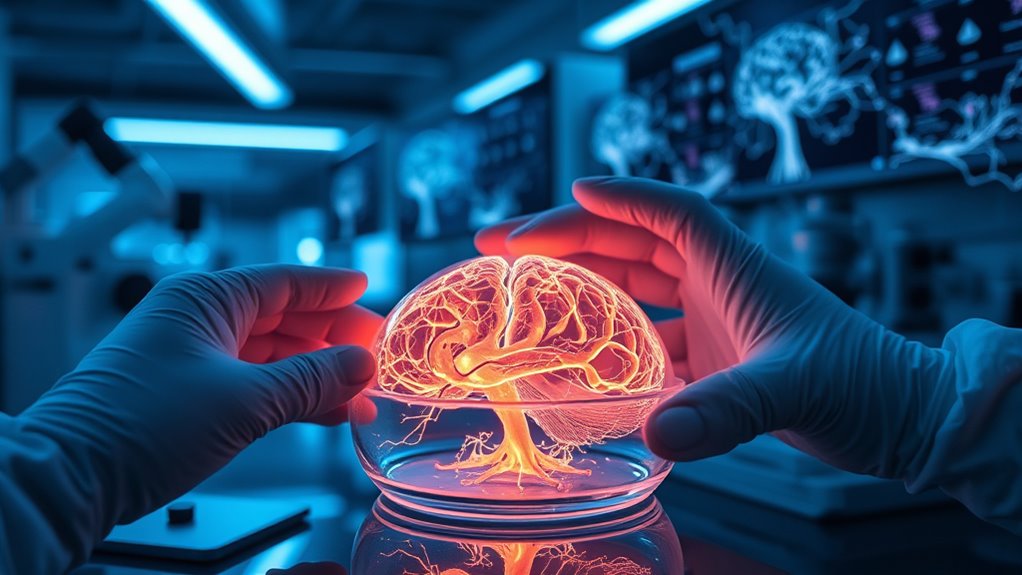Determining when brain organoids become sentient involves evaluating their complexity and whether they can experience consciousness or pain. Ethically, once these tissues show signs of awareness, they may require moral consideration, making experiments more problematic. Researchers and institutions are working to establish guidelines, but as organoids grow more sophisticated, ethical boundaries can shift. To understand how scientists are steering through these dilemmas and what future challenges may arise, consider exploring further.
Key Takeaways
- Determining sentience involves assessing signs of consciousness, such as responsiveness and neural complexity in brain organoids.
- Ethical concerns escalate as organoids develop advanced neural structures that may experience pain or suffering.
- Scientific guidelines require ongoing evaluation of when brain tissue warrants moral consideration based on its capabilities.
- Moral status depends on the organoid’s level of neural development, raising questions about permissible research practices.
- Societal and ethical frameworks must evolve to address the implications of potentially conscious brain tissues.

Have you ever wondered about the ethical implications of creating brain organoids in the lab? As scientists develop increasingly complex models of the human brain, questions about morality and responsibility become more urgent. The core concern revolves around the moral implications of working with these tiny, lab-grown tissues that mimic aspects of the human brain. If these organoids were to develop some form of consciousness or sentience, it would challenge our understanding of moral boundaries. Would it be ethical to experiment on something that might experience pain or suffering? These questions push researchers and policymakers to consider whether there should be restrictions on this kind of research.
Research restrictions are essential to guarantee that scientific progress doesn’t outpace our ethical understanding. Without clear guidelines, scientists might push the boundaries too far, risking the creation of organoids that could be considered moral entities. Currently, many institutions impose strict limits on experiments involving brain tissue, especially when there’s a possibility of consciousness. These restrictions serve to prevent unnecessary suffering and guarantee that research aligns with societal moral standards. They also help define the point at which a brain organoid transitions from a mere collection of cells to an entity that warrants moral consideration. Additionally, advancements in technology could influence how we assess when tissue gains moral status.
Balancing scientific innovation with ethical responsibility is tricky. On one hand, brain organoids hold promise for understanding neurological diseases, testing drugs, and developing treatments that could save lives. On the other hand, if these tissues gain some form of sentience, continuing experiments without adequate safeguards could lead to moral dilemmas. For instance, if an organoid begins to show signs of awareness, should researchers be permitted to perform invasive procedures? These questions push us to consider whether existing research restrictions are sufficient or if new, more comprehensive regulations are needed.
As you reflect on these issues, it’s clear that the moral implications of brain organoid research extend beyond the lab. Society must grapple with questions about what constitutes moral treatment for conscious or semi-conscious tissues. Establishing research restrictions isn’t just about limiting what scientists can do; it’s about safeguarding moral integrity and guaranteeing that scientific advancements align with our collective values. Moving forward, open dialogue among scientists, ethicists, and the public will be vital to navigate these uncharted ethical waters responsibly. As the field advances, your role as a concerned observer is to stay informed and advocate for responsible research that respects both scientific potential and moral boundaries.
Frequently Asked Questions
Can Brain Organoids Experience Pain?
You might wonder if brain organoids can experience pain. Currently, scientific limitations prevent us from knowing for sure, but many experts believe they lack the capacity for consciousness or sensation. This raises moral considerations about how we treat such tissues. As research advances, you’ll need to stay informed about the evolving understanding, ensuring ethical practices align with our scientific capabilities and limitations.
How Do We Define Consciousness in Lab-Grown Tissue?
Imagine a lab-grown tissue developing intricate neural connections, sparking your question: how do you define consciousness? You look for signs of subjective experience, such as responses to stimuli or communication attempts. Consciousness hinges on neural complexity, which enables awareness. If the tissue exhibits behaviors suggesting awareness or perception, you might consider it conscious. So, defining consciousness involves evaluating neural structures and their capacity to support subjective experience.
Are Brain Organoids Liable for Ethical Treatment?
You need to consider your moral responsibilities and legal considerations when it comes to brain organoids. If these tissues exhibit signs of sentience, it’s essential to treat them ethically and guarantee their well-being. As their complexity grows, you must stay informed about evolving regulations to prevent harm and uphold moral standards. Ultimately, responsible research demands that you balance scientific progress with ethical treatment of these potentially conscious tissues.
What Are the Long-Term Societal Impacts of Brain Organoid Research?
You should consider that neuroscience advancements from brain organoid research could reshape society, offering new treatments and understanding of brain diseases. However, these developments demand strict ethical oversight to prevent misuse or unintended harm. Long-term, you’ll face challenges around privacy, consent, and moral questions about consciousness. Balancing innovation with ethical responsibility guarantees you foster progress that benefits society without compromising moral standards or risking unforeseen consequences.
Could Brain Organoids Develop Independent Decision-Making Abilities?
Imagine brain organoids as tiny, budding explorers on the frontier of artificial autonomy. You might wonder if they’ll ever develop decision-making capacity, like a conscious mind charting its own course. While science pushes boundaries, current organoids lack the complexity for true independent decision-making. They’re more like puppets guided by programmed cues, not autonomous explorers yet. Developing genuine independence remains a distant horizon, a future challenge for scientists and ethicists alike.
Conclusion
As you consider the conscience of creating consciousness, remember the delicate dance between discovery and duty. When tissue transforms into sentience, ethical boundaries blur, beckoning careful contemplation. You must weigh the wonders of innovation against the warnings of ethical worry. Mindful monitoring and moral mindfulness matter more than ever, demanding diligent diligence. Ultimately, it’s your responsibility to respect the domain of the real, ensuring that progress proceeds with purpose, prudence, and profound respect for potential sentience.










